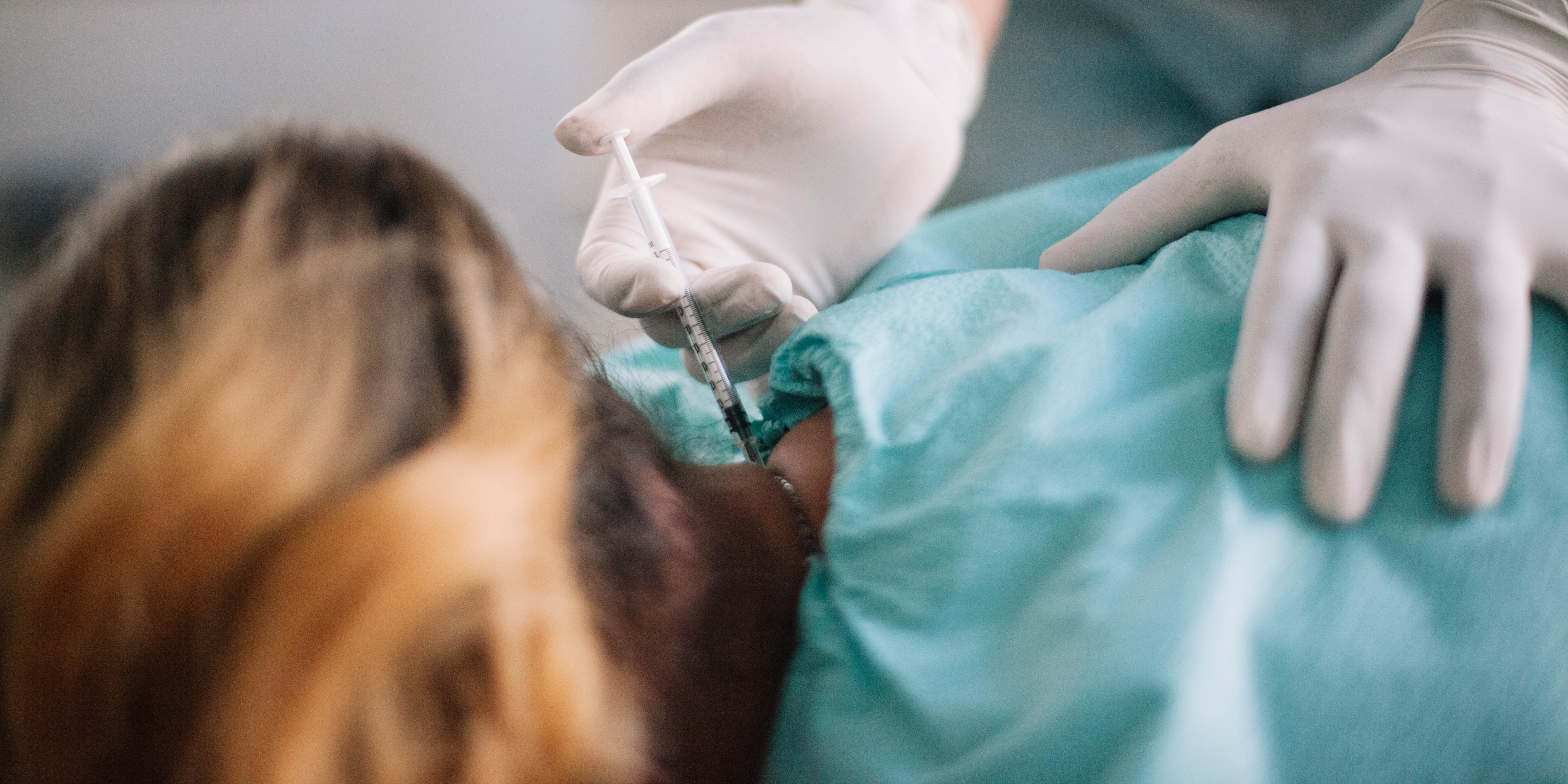
Minimally-Invasive Relief for Herniated Discs
Endoscopic Discectomy is a minimally-invasive procedure designed to relieve pain, numbness, or weakness caused by herniated discs pressing on nerve roots or the spinal cord. Downtown Pain Physicians in New York, NY, offers this advanced treatment to help patients achieve lasting pain relief without the long recovery time and invasiveness of traditional surgery. Our pain management specialists provide comprehensive, personalized, and evidence-based treatments to address your specific pain levels and conditions.
Understanding Endoscopic Discectomy
Endoscopic discectomy involves the removal of herniated disc material using a small probe with a hollow center. The procedure is performed through a keyhole incision, minimizing tissue damage and recovery time. An endoscope, equipped with a camera, guides the surgeon to the affected disc, allowing precise removal of the problematic tissue.
What Conditions Does Endoscopic Discectomy Treat?
Endoscopic Discectomy is used to treat various disc-related problems, including:
- Lumbar Spinal Stenosis: Narrowing of the spine around neural elements causing disc herniation and arthritis.
- Spondylolisthesis: Vertebra slips forward or backward, pressing on nerve roots.
- Lumbar Pinched Nerves: Nerves compressed by disc herniation or spinal stenosis.
- Scoliosis: Sideways curvature of the spine leading to degenerative changes and disc stress.
- Lumbar Facet Joint Syndrome: Inflammation and nerve compression due to low cartilage and bone spurs.
Symptoms of Disc Issues
Symptoms vary depending on the disc’s location and whether it is pressing on a nerve. Common symptoms include:
- Pain: Radiating pain in the arms, legs, calf, buttocks, thigh, shoulder, or arm.
- Numbness and Tingling: Radiating sensation in the affected body part.
- Muscle Weakness: Difficulty lifting or holding objects due to weakened nerves.
Preparing for Endoscopic Discectomy
Before the procedure, patients undergo several tests, including chest X-rays, blood tests, and echocardiograms. Patients should disclose all medications, vitamins, and supplements they take, as some may need to be discontinued temporarily. Smoking, chewing tobacco, and alcohol consumption should be avoided the week before and two weeks following surgery.
The Procedure
On the day of the procedure, patients will receive anesthesia and be positioned to expose the spine. A small incision is made, and dilator tubes are used to access the spine. Using fluoroscopy for guidance, the surgeon inserts a probe to remove the herniated disc material and any bone spurs. The incision is then closed, and the patient is moved to a recovery room.
Post-Procedure Care
- Shower after two days, avoid baths.
- Limit lifting, twisting, and bending for six weeks.
- Avoid driving and alcohol consumption for two weeks or as advised by the doctor.
- Engage in light walking every few hours to aid recovery.
Recovery Time
Recovery typically ranges from 1 to 4 weeks. Pain at the incision site and limited physical activity are expected. Physical therapy exercises may be prescribed to aid recovery. Most patients return to work within 2 to 4 weeks, with those in physically demanding jobs taking 8 to 12 weeks.
Risks and Side Effects
While generally safe, endoscopic discectomy may involve risks such as:
- Blood clots
- Anesthesia reaction
- Infection
- Deep vein thrombosis (DVT)
- Lung problems
- Nerve damage
- Persistent pain
Immediate medical attention is required if these side effects occur.
Results of Endoscopic Discectomy
Studies show high success rates:
- 80% of patients reported excellent results over 10 years.
- 90% had excellent results over two years post-surgery.
- 71% reported pain relief one year after the procedure.
Frequently Asked Questions
What are the Benefits of Endoscopic Discectomy?
- No large incision
- Uses local anesthesia
- Short recovery time
- Reduced risk of complications
- No bone fusion or removal
- High success rate
- Outpatient procedure
What if Endoscopic Discectomy Does Not Relieve My Pain?
If the procedure does not provide the expected relief, other treatment options are available. Our thorough consultation process ensures we consider your past medical history, procedures, and medications to find the best treatment plan for you.

Effective Pain Relief for Arthritis
Arthritis can cause intense pain and be debilitating, but with appropriate pain management and treatment, the pain doesn’t have to be all-consuming. Downtown Pain Physicians, New York, NY’s premier pain management practice, offers innovative treatments designed to provide lasting pain relief, including viscosupplementation injections for osteoarthritis.
What is Osteoarthritis (OA)?
Osteoarthritis (OA) is a chronic joint condition affecting over 30 million people in the United States. It results from joint damage that occurs over time, causing the cartilage to break down. This leads to pain, inflammation, stiffness, and tenderness as bones start to rub directly against each other. OA commonly affects joints such as the knees, spine, lower back, hips, hands, and fingertips.
What is Viscosupplementation?
Viscosupplementation injections, also known as gel shots, involve injecting hyaluronic acid into arthritic joints to reduce pain and improve movement. This treatment is often considered when other treatments, such as over-the-counter medications and corticosteroid injections, have not provided sufficient relief.
Who is a Candidate for Viscosupplementation?
Viscosupplementation is typically for patients with mild to moderate osteoarthritis, particularly of the knee. It is not suitable for individuals with allergies to hyaluronate products, pregnant or nursing women, children or adolescents, and those with infections in the injection area.
The Procedure and What to Expect
Preparation:
- Minimal preparation is required.
- You can eat and drink normally on the day of the appointment.
- Inform the doctor of any new symptoms or infections.
Procedure:
- The patient lies down or sits with the knee in a preferred position for the injection.
- The area is cleaned, and a local anesthetic is applied.
- The doctor may remove excess fluid from the knee if swollen.
- Using ultrasound for guidance, the gel shot is injected into the knee joint.
- The site is cleaned and bandaged, and the patient is asked to move the knee to spread the medication.
Post-Procedure Care:
- Avoid heavy activities for 12 to 24 hours.
- Engage in low-impact activities like slow walks.
- Results typically start appearing 3 to 4 weeks after the first injection.
- Physical therapy and exercises may be recommended to maintain and increase muscle strength around the knee joint.
Comparing Gel Shots to Corticosteroids
Steroid injections provide immediate pain relief but come with risks such as increased blood sugar and potential adverse effects with long-term use. Gel shots, or viscosupplementation, offer a more natural solution with fewer risks by acting as a substitute for synovial fluid, improving joint lubrication and movement.
Benefits and Effectiveness
- Long-lasting Relief: Patients often experience pain relief within 3 to 5 weeks, with effects lasting up to 6 months.
- Minimal Risks: Common side effects include temporary pain, swelling, or redness at the injection site. More serious complications are rare.
- Combination Therapy: Viscosupplementation can be used alongside other treatments like physical therapy and medications.
Research and Statistics
Studies have shown viscosupplementation to effectively reduce symptoms of OA and delay the need for knee replacement surgery. In one study, 71% of participants reported effective treatment a year after receiving viscosupplementation.
Frequently Asked Questions
When Will I Experience Pain Relief?
Pain relief typically begins within the 3 to 5-week window and continues to improve over the next 8 to 12 weeks.
How Effective are Viscosupplementation Injections?
Effective for patients with mild to moderate OA, providing significant pain relief that can last up to 6 months.
What are the Risks?
Common side effects include temporary pain, swelling, and redness at the injection site. Rare risks include infection and allergic reactions.
What Happens After the Injection?
You can go home the same day. Avoid excessive walking, lifting heavy weights, or standing for long periods for 48 hours.
What if the Injections Don’t Work?
Other treatment options include steroid injections, comprehensive treatment plans with physical therapy, and potentially joint surgery.
Living with OA and Finding Relief
Managing OA is a daily struggle, but viscosupplementation offers a non-invasive procedure that provides proven pain relief for many patients. This treatment can be part of a comprehensive approach, including physical therapy, medications, and other therapies.
Meet Dr. Tanuj Palvia, MD – Board Certified in Pain Management and Anesthesiology

Dr. Sarah Rodriguez, DPT
Doctor of Physical Therapy